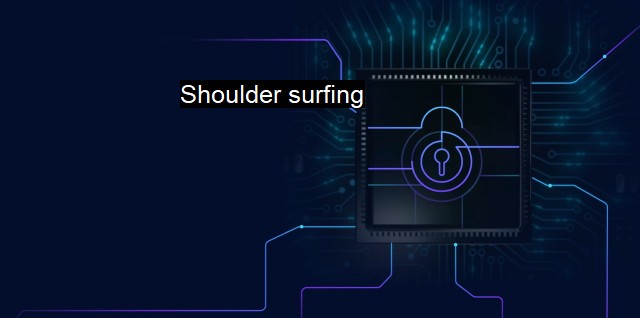What is Shoulder surfing?
Shoulder Surfing: A Common Social Engineering Attack in the Cybersecurity World that Aims to Steal Sensitive Information.
Shoulder surfing is a popular and common term used in the realm of cybersecurity. It refers to the act of an attacker secretly spying over someone's shoulder to catch valuable and confidential information. Shoulder surfer may be someone hovering behind or near you at a public facility such as an ATM, expenditure desk, or while making a digital purchase in order to steal confidential information such as passwords, personal identification numbers (PINs), or credit card details. This technique may seem unsophisticated compared to some complex cyberattacks, but it can have dangerous consequences if sensitive information is stolen.Shoulder surfing isn’t confined to just public spaces, but it can also occur while working in an office environment. Seasoned attackers have a knack for blending into the background or making their interest appear innocent while stealing identity relevant information. Modern-day shoulder surfers have also leveraged binoculars and spy cameras to carry out distant observations acquiring sophisticated invasiveness.
The risk that shoulder surfers pose to businesses and individuals is significant. This method of data hacking has boomed with the increase in mobile and personal computing usage. For corporations, shoulder surfing poses hefty financial risks as it may lead to unwarranted access and control over exclusive corporate information. Once a perpetrator gets hold of such data, they could potentially make unauthorized transactions, carry out malicious operations, steal client information, or commit other forms of potential financial fraud. The fallout from shoulder surfing attacks doesn’t stop at finances but has potential effects on reputation and customer relations detriment too.
Shoulder surfing can also lead to the spread of viruses. Whenever someone falls victim to this scam, the perpetrator gains unauthorized access to personal devices. They might also send the victim malware or Trojan-infected files hidden behind genuine-looking links or attachments. This can lead to different types of viruses or malware penetrating the system without the victim's knowledge, thus compromising device security.
In light of shoulder surfing's sheer potential in causing data breaches and spreading malware, individuals ought to deploy protective measures. A first, efficient step in minimizing the risk is a clear awareness of physical surroundings. Businesses should also encourage employees to avoid working on sensitive tasks in public spaces but instead, value privacy and discretion even in pacing out their work.
Anti-shoulder surfing measures also take the form of password management tools such as managers and encryption tools besides the implementation of protocols to prohibit sharing login credentials. screens to protect data from prying eyes can make it more difficult for cybercriminals to gather data visually. Incorporating regular mock phishing attacks and educating employees on shoulder surfing and other forms of cyberattacks fosters a defense mechanism culture.
Anti-virus software too is widely recognized as a counteractive measure and solution against potential hacks of this nature. This software scans computer systems for known threats and flags or removes any threats it comes across to keep systems safe. Regular, automatic updates ensure that the antivirus software defenses are up-to-date and capable of combating the latest threats.
Holistic cybersecurity involves appreciating overlooked threats such as shoulder surfing. The fact that it lacks technical sophistication compared to other forms of cyber attacker makes tracking and addressing instances of shoulder surfing more challenging. Thus, to safeguard valuable information, one cannot overlook the gravity associated with this traditional kind of spying. Cybersecurity measures need to be robust, encompassing rudimentary attack forms like shoulder surfing all the while guarding against complex cyberattacks as well.

Shoulder surfing FAQs
What is shoulder surfing in the context of cybersecurity?
Shoulder surfing is a technique used by hackers to steal sensitive information by looking over someone's shoulder while they are using their computer, mobile device, or ATM. This technique is often used to obtain personal identification numbers (PINs), login credentials, and other confidential information.How does shoulder surfing pose a security threat to individuals and organizations?
Shoulder surfing can compromise the security of individuals and organizations by allowing hackers to gather confidential information. This information can be used to steal identities, personal and financial data, and other sensitive information. This can result in financial loss, reputational damage, and legal issues for the affected parties.What are some measures that individuals and organizations can take to prevent shoulder surfing attacks?
To prevent shoulder surfing attacks, individuals and organizations can take measures such as using privacy filters on screens, avoiding conducting sensitive activities in public places, using two-factor authentication, using strong passwords, and periodically checking their surroundings for suspicious individuals. Additionally, organizations can conduct security training and awareness programs to educate their employees about the risks and ways to prevent shoulder surfing attacks.Can antivirus software protect against shoulder surfing attacks?
Antivirus software is designed to protect against malware, viruses, and other software-based threats. While antivirus software can help protect against certain types of cyber attacks, it cannot protect against shoulder surfing attacks. Preventing shoulder surfing attacks requires physical security measures and security awareness among individuals and organizations.| | A | | | B | | | C | | | D | | | E | | | F | | | G | | | H | | | I | | | J | | | K | | | L | | | M | |
| | N | | | O | | | P | | | Q | | | R | | | S | | | T | | | U | | | V | | | W | | | X | | | Y | | | Z | |
| | 1 | | | 2 | | | 3 | | | 4 | | | 7 | | | 8 | | |||||||